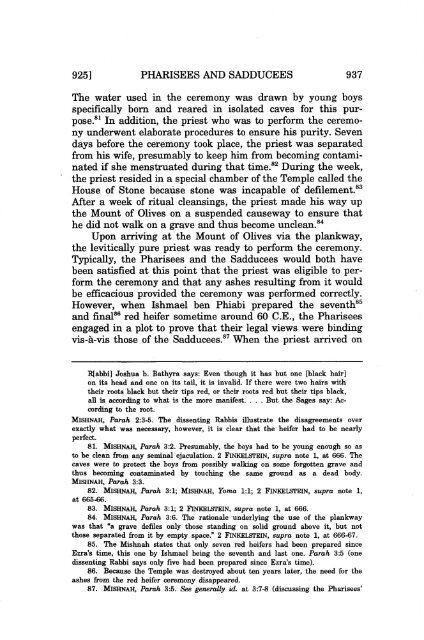The Pharisees and the Sadducees: Rethinking Their Respective ...
The Pharisees and the Sadducees: Rethinking Their Respective ...
The Pharisees and the Sadducees: Rethinking Their Respective ...
You also want an ePaper? Increase the reach of your titles
YUMPU automatically turns print PDFs into web optimized ePapers that Google loves.
'<br />
9251 PHARISEES AND SADDUCEES 937<br />
<strong>The</strong> water used in <strong>the</strong> ceremony was drawn by young boys<br />
specifically born <strong>and</strong> reared in isolated caves for this pur-<br />
pose.81 In addition, <strong>the</strong> priest who was to perform <strong>the</strong> ceremo-<br />
ny underwent elaborate procedures to ensure his purity. Seven<br />
days before <strong>the</strong> ceremony took place, <strong>the</strong> priest was separated<br />
from his wife, presumably to keep him from becoming contami-<br />
nated if she menstruated during that time.s2 During <strong>the</strong> week,<br />
<strong>the</strong> priest resided in a special chamber of <strong>the</strong> Temple called <strong>the</strong><br />
House of Stone because stone was incapable of defilement.s3<br />
After a week of ritual cleansings, <strong>the</strong> priest made his way up<br />
<strong>the</strong> Mount of Olives on a suspended causeway to ensure that<br />
he did not walk on a grave <strong>and</strong> thus become unclean.s4<br />
Upon arriving at <strong>the</strong> Mount of Olives via <strong>the</strong> plankway,<br />
<strong>the</strong> levitically pure priest was ready to perform <strong>the</strong> ceremony.<br />
Typically, <strong>the</strong> <strong>Pharisees</strong> <strong>and</strong> <strong>the</strong> <strong>Sadducees</strong> would both have<br />
been satisfied at this point that <strong>the</strong> priest was eligible to per-<br />
form <strong>the</strong> ceremony <strong>and</strong> that any ashes resulting from it would<br />
be efficacious provided <strong>the</strong> ceremony was performed correctly.<br />
However, when Ishmael ben Phiabi prepared <strong>the</strong> sevenths5<br />
<strong>and</strong> finals6 red heifer sometime around 60 C.E., <strong>the</strong> <strong>Pharisees</strong><br />
engaged in a plot to prove that <strong>the</strong>ir legal views were binding<br />
vis-his those of <strong>the</strong> <strong>Sadducees</strong>." When <strong>the</strong> priest arrived on<br />
R[abbi] Joshua b. Bathyra says: Even though it has but one [black hair]<br />
on its head <strong>and</strong> one on its tail, it is invalid. If <strong>the</strong>re were two hairs with<br />
<strong>the</strong>ir roots black but <strong>the</strong>ir tips red, or <strong>the</strong>ir roots red but <strong>the</strong>ir tips black,<br />
all is according to what is <strong>the</strong> more manifest. . . . But <strong>the</strong> Sages say: According<br />
to <strong>the</strong> root.<br />
MISHNAH, Parah 2:3-5. <strong>The</strong> dissenting Rabbis illustrate <strong>the</strong> disagreements over<br />
exactly what was necessary, however, it is clear that <strong>the</strong> heifer had to be nearly<br />
perfect.<br />
81. MISHNAH, Parah 3:2. Presumably, <strong>the</strong> boys had to be young enough so as<br />
to be clean from any seminal ejaculation. 2 FINKELSTEIN, supra note 1, at 666. <strong>The</strong><br />
caves were to protect <strong>the</strong> boys from possibly walking on some forgotten grave <strong>and</strong><br />
thus becoming contaminated by touching <strong>the</strong> same ground as a dead body.<br />
MISHNAH, Parah 3:3.<br />
82. MISHNAH, Parah 3:l; MISHNAH, Yoma 1:l; 2 FINKELSTEIN, supra note 1,<br />
at 665-66.<br />
83. MISHNAH, Parah 3:l; 2 FINKELSTEIN, supra note 1, at 666.<br />
84. MISHNAH, Parah 3:6. <strong>The</strong> rationale underlying <strong>the</strong> use of <strong>the</strong> plankway<br />
was that "a grave defiles only those st<strong>and</strong>ing on solid ground above it, but not<br />
those separated from it by empty space." 2 FINKELSTEIN, supra note 1, at 666-67.<br />
85. <strong>The</strong> Mishnah states that only seven red heifers had been prepared since<br />
Ezra's time, this one by Ishmael being <strong>the</strong> seventh <strong>and</strong> last one. Parah 3:5 (one<br />
dissenting Rabbi says only five had been prepared since Ezra's time).<br />
86. Because <strong>the</strong> Temple was destroyed about ten years later, <strong>the</strong> need for <strong>the</strong><br />
ashes from <strong>the</strong> red heifer ceremony disappeared.<br />
87. MISHNAH, Parah 3:5. See generally id. at 3:7-8 (discussing <strong>the</strong> <strong>Pharisees</strong>'


